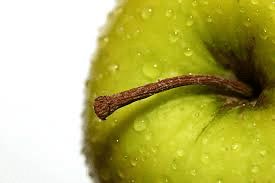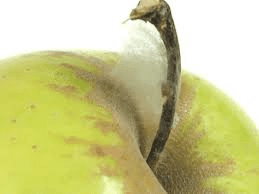The apple stems, also known as the apple peduncle, is the part of the apple fruit that connects it to the apple tree. It plays a crucial role in the fruit’s development and attachment to the tree, serving as a conduit for nutrients and water from the tree to the fruit. The stem is a relatively small but significant component of the apple, with several key functions and characteristics.
Structurally, the apple stem is a short, thickened extension of the tree’s branches. It is composed of vascular tissues that include xylem and phloem. The xylem transports water and dissolved minerals from the roots of the tree to the fruit, while the phloem carries the sugars and other nutrients produced in the leaves down to the fruit. This vascular system is essential for the apple’s growth, as it ensures that the fruit receives the necessary resources to develop properly.
The apple stem also provides physical support, holding the fruit securely on the tree. This attachment is crucial for the fruit’s development, as it allows the apple to remain in place while it grows and ripens. The stem’s strength and integrity help prevent the fruit from falling prematurely, which could lead to damage or loss.
During the fruit’s maturation process, the apple stem undergoes changes. As the fruit ripens, the stem may become softer and more pliable. This change is part of the natural aging process of the fruit, which also involves the softening of the apple’s flesh, the development of its flavor, and changes in its color. The stem’s condition can be an indicator of the apple’s ripeness and overall quality.
From a horticultural perspective, the health of the apple stem is important for fruit quality and yield. A healthy, strong stem ensures that the fruit remains well-attached and can continue to receive nutrients from the tree. However, stems can be susceptible to various issues, including pests and diseases. For example, certain fungal infections or insect infestations can weaken the stem, affecting the fruit’s development and potentially leading to premature fruit drop.
In addition to its functional role, the apple stem can also provide insights into the apple’s harvest and storage. For instance, if the stem is too weak or damaged, it might indicate that the fruit is not as fresh or has been subjected to environmental stress. Conversely, a strong and healthy stem suggests that the apple is likely to have been properly cared for during its growth.
The apple stems are also a point of interest in apple breeding and cultivation. Research on the stem’s characteristics can help in developing apple varieties that have improved fruit attachment, disease resistance, and overall fruit quality. Advances in agricultural practices and technology often focus on optimizing stem health to enhance fruit production and yield.
The apple stems are vital part of the apple fruit, providing essential support and serving as a conduit for nutrients and water from the apple tree. Its condition can impact the quality and ripeness of the apple, and it is an important consideration in horticulture and fruit cultivation. Understanding the role of the apple stem helps in appreciating the complex processes involved in apple production and in ensuring the health and quality of the fruit.
The Economic Importance and Uses of Apple Stems

1. Composting: Apple stems can be composted to enrich soil with organic matter and nutrients.
2. Craft Projects: Apple stems can be used in various craft projects, such as making rustic decorations or creating small wooden items.
3. Firewood: Apple stems can be used as firewood, providing a source of heat and energy.
4. Herbal Medicine: Apple stems are sometimes used in traditional medicine for their potential therapeutic properties.
5. Natural Mulch: Apple stems can be shredded and used as mulch to help retain soil moisture and suppress weeds.
6. Animal Bedding: Shredded apple stems can be used as bedding material for small animals.
7. Biofuel: Apple stems can be processed into biofuel, providing a renewable energy source.
8. Furniture Making: Apple wood, including stems, can be used to make small furniture items or decorative pieces.
9. Garden Supports: Apple stems can be used as natural supports or stakes for plants in the garden.
10. Educational Tools: Apple stems can be used in educational settings to teach about plant biology and environmental science.
11. Eco-Friendly Packaging: Apple stems can be used to create biodegradable packaging materials.
12. Artistic Carvings: Apple stems can be carved into artistic pieces or sculptures.
13. Potpourri: Dried apple stems can be included in potpourri blends for a natural, aromatic addition.
14. Natural Dyes: Apple stems can be used to produce natural dyes for textiles and crafts.
15. Soil Erosion Control: Apple stems can be used in erosion control projects to stabilize soil.
16. Garden Decorations: Apple stems can be used in garden decorations, such as plant supports or decorative features.
17. Craft Materials: Apple stems can be used in various craft projects, such as creating rustic wreaths or ornaments.
18. Biomass: Apple stems can be used as biomass for generating energy or heat.
Read Also: The Benefits of Using Vietnamese Coriander Spices on Your Cooking
The Products and By-products That Can Be Derived From Apple Stems

1. Compost: Apple stems decomposed into nutrient-rich compost for gardening.
2. Craft Items: Apple stems used in making decorative crafts and small wooden items.
3. Firewood: Apple stems used as firewood for heating and energy.
4. Herbal Remedies: Extracts from apple stems used in traditional medicine.
5. Mulch: Shredded apple stems used as natural mulch in gardens.
6. Animal Bedding: Shredded apple stems used as bedding for small animals.
7. Biofuel: Processed apple stems used as a renewable energy source.
8. Furniture: Apple wood, including stems, used in making small furniture items.
9. Garden Supports: Apple stems used as natural stakes or supports for plants.
10. Educational Materials: Apple stems used in teaching about plant biology and environmental science.
11. Eco-Friendly Packaging: Apple stem fibers used to create biodegradable packaging.
12. Artistic Carvings: Apple stems carved into artistic pieces or sculptures.
13. Potpourri: Dried apple stems included in potpourri blends.
14. Natural Dyes: Dyes produced from apple stems for textiles and crafts.
15. Soil Erosion Control: Apple stems used in projects to stabilize soil and prevent erosion.
16. Garden Decorations: Apple stems used in decorative features for gardens.
17. Craft Materials: Apple stems used in creating rustic crafts, wreaths, or ornaments.
18. Biomass: Apple stems used as biomass for energy generation.
Read Also: Growing Guide and Health Benefits of Coriander Spices
Frequently Asked Questions (FAQ’s) About Apple Stem

1. What is an apple stem?
The apple stem is the small, woody part that connects the apple to the tree branch.
2. Can apple stems be used in composting?
Yes, apple stems can be composted to add organic matter and nutrients to the soil.
3. Are apple stems suitable for craft projects?
Yes, apple stems can be used in various craft projects, such as decorations and small wooden items.
4. Can apple stems be used as firewood?
Yes, apple stems can be used as firewood, providing a source of heat and energy.
5. How are apple stems used in traditional medicine?
Apple stems are used in traditional medicine for their potential therapeutic properties.
6. Can apple stems be used as mulch?
Yes, shredded apple stems can be used as mulch to retain soil moisture and suppress weeds.
7. Are apple stems good for animal bedding?
Yes, shredded apple stems can be used as bedding material for small animals.
8. How can apple stems be used as biofuel?
Apple stems can be processed into biofuel, offering a renewable energy source.
9. Can apple stems be used in furniture making?
Yes, apple wood from stems can be used to create small furniture items or decorative pieces.
10. How are apple stems used in garden support?
Apple stems can be used as natural stakes or supports for plants in the garden.
Read Also: Top 15 Healthy Foods for your Body

